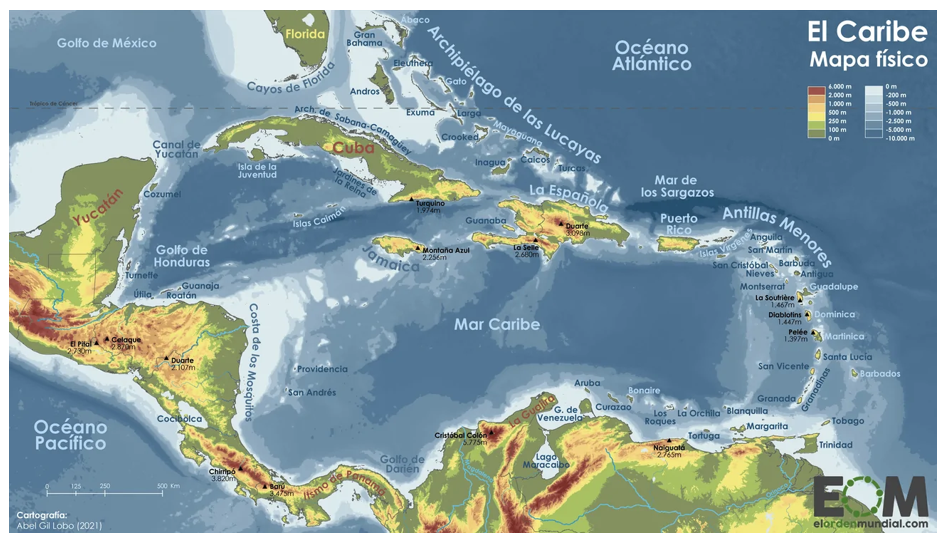Condiciones oceánicas favorables para el arribo de sargazos a las costas cubanas
Contenido principal del artículo
Resumen
Los sargazos son un género de macroalgas marinas de origen Sargassum que carecen de nado propio, pues dependen de la circulación oceánica y atmosférica para su desplazamiento, por lo que el viento, las olas y las corrientes marinas resultan factores imprescindibles para su movimiento. Es por ello, que se plantea como objetivo analizar el estado del mar y el comportamiento de las corrientes marinas en las costas de Cuba y mares adyacentes y su relación con la llegada de sargazos a los litorales cubanos. En esta investigación se utilizaron los datos del estado del mar en las costas cubanas, así como los datos de corrientes marinas cerca de los litorales cubanos y mares adyacentes. Se determinó que, el poco oleaje pudo favorecer la llegada de sargazos hacia las costas cubanas, principalmente en occidente y oriente. Además, se demostró que tanto los flujos de corrientes ciclónicos y anticiclónicos cerca de los litorales cubanos, así como las líneas de corrientes que fluyen hacia la costa norte y sur del archipiélago, resultan factores importantes en el arribo de sargazos.
Descargas
Detalles del artículo

Esta obra está bajo licencia internacional Creative Commons Reconocimiento-NoComercial 4.0.
Aquellos autores/as que tengan publicaciones con esta revista, aceptan los términos siguientes de la Licencia CC Reconocimiento-NoComercial 4.0 Internacional (CC BY-NC 4.0):
Usted es libre de:
- Compartir — copiar y redistribuir el material en cualquier medio o formato
- Adaptar — remezclar, transformar y crear a partir del material
El licenciador no puede revocar estas libertades mientras cumpla con los términos de la licencia.
Bajo las condiciones siguientes:
- Reconocimiento — Debe reconocer adecuadamente la autoría, proporcionar un enlace a la licencia e indicar si se han realizado cambios. Puede hacerlo de cualquier manera razonable, pero no de una manera que sugiera que tiene el apoyo del licenciador o lo recibe por el uso que hace.
- NoComercial — No puede utilizar el material para una finalidad comercial.
- No hay restricciones adicionales — No puede aplicar términos legales o medidas tecnológicas que legalmente restrinjan realizar aquello que la licencia permite.
La revista no se responsabiliza con las opiniones y conceptos emitidos en los trabajos, son de exclusiva responsabilidad de los autores. El Editor, con la asistencia del Comité de Editorial, se reserva el derecho de sugerir o solicitar modificaciones aconsejables o necesarias. Son aceptados para publicar trabajos científico originales, resultados de investigaciones de interés que no hayan sido publicados ni enviados a otra revista para ese mismo fin.
La mención de marcas comerciales de equipos, instrumentos o materiales específicos obedece a propósitos de identificación, no existiendo ningún compromiso promocional con relación a los mismos, ni por los autores ni por el editor.
Citas
Frazier, J.T., T.L., Linton, R.K., Webster. 2014. Advanced prediction of the Intra-Americas Sargassum season through analysis of the Sargassum Loops System using remote sensing technology. Journal of the American Shore and Beach Preservation Association. 83(4): 15-21.
Gavio, B., M.N., Rincón-Díaz, A., Santos-Martínez. 2015. Massive quantities of pelagic Sargassum on the shores of San Andres Island, southwestern Caribbean. Acta bio. Colomb. 20(1): 239-241.
Gower J., E. Young, y S. King, 2013. Satellite images suggest a new Sargassum source region in 2011. Remote Sensing Letters, 4(8): 764-773. doi:10.1 080/2150704X.2013.796433
Hernández-Lara J.A. (2023). Dinámica del transporte de sargazo pelágico en el Caribe mexicano. Universidad Nacional Autónoma de México. Thesis · September 2023. DOI: 10.13140/RG.2.2.30002.99526.
Hill B (2016) An Analysis of the Factors That Influence the Sargassum Migratory Loop. Texas A&M University. Tesis De Maestría, 30 Pp.
Huffard, C.L., S. von Thun, A.D. Sherman. 2014. Pelagic Sargassum community change over a 40-year period: temporal and spatial variability. Marine Biology. 161: 2735-2751.
Martínez-González, G. (2019). Sargazo: la irrupción atípica de un ecosistema milenario. Salud pública de méxico / vol. 61, no. 5, septiembre-octubre de 2019.
Mitrani, I. (2017). METEOROLOGÍA MARINA. La Habana. Cuba: Citmatel
NOAA. 2015. What is the Sargasso Sea? Disponible en: http://oceanservice.noaa.gov/facts/sargassosea.html.
Rodríguez, R.E., Van Tussenbroek, B.I. (2020). El sargazo en los pastos marinos y arrecifes. Ciencia. Revista de la Academia mexicana de Ciencias. Vol.71 Num.4
Wang, M., y C. Hu, 2016. Mapping and quantifying Sargassum distribution and coverage in the Central West Atlantic using MODIS observations. Remote Sensing of Environment, 183: 350-367. doi: 10.1016/j.rse.2016.04.019
Wang, M., Ch. Hu, B. B. Barnes, G. Mitchum, B. Lapointe y J. P. Montoya (2019), “The great Atlantic Sargassum belt”, Science, 365:83-87. Disponible en: doi.org/10.1126/science.aaw7912
Webster R, Linton T (2013) Development and Implementation of Sargassum Early Advisory System (SEAS). Shore & Beach 81, 1-6.

